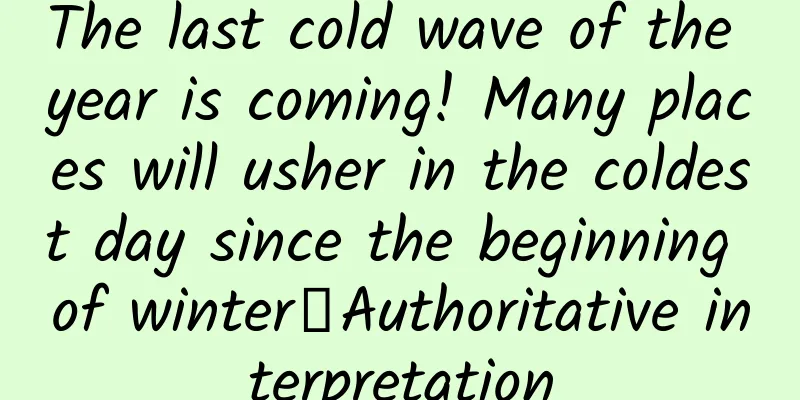The last cold wave of the year is coming! Many places will usher in the coldest day since the beginning of winter丨Authoritative interpretation

|
The year-end cold wave is coming! December 23-26 my country's central and eastern regions will be affected by cold waves again Turn on the "Quick Freeze" mode to this end The Central Meteorological Observatory issued a Blue warning for cold wave China Meteorological Administration launched Level 4 emergency response Kind tips The intensity of this cooling is second only to Cold wave weather process from November 4 to 9 This will be the last cold wave in 2021 After the cold front Temperatures will hit new lows this winter in large areas The temperature will drop all the way south to Hainan 27 provincial capital cities The coldest weather in the second half of the year Affected by the cold wave, it is expected that from December 23 to 26 Temperatures in central and eastern my country dropped by 6-10°C Central and western Inner Mongolia, northern and western North China, and eastern Huanghuai Eastern Jianghuai, Eastern Jiangnan, and Eastern Guizhou Temperatures in parts of western Hunan and other places dropped by 12 to 14 degrees Celsius Local temperature above 14℃ Around 25th The highest temperature in most parts of the north is below 0℃ There will be 4-5 magnitude storms in the middle and lower reaches of the Yangtze River and its northern areas. Northerly wind with gusts of 6 to 8 On the morning of the 27th and 28th, the lowest temperature is 0℃ It will be located in the southern part of Jiangnan to the southern part of Guizhou This is the southernmost point since the beginning of winter this year. The southern region will experience the lowest temperature since the beginning of winter this year ❄️Rainy and snowy weather❄️ Affected by both cold and warm air December 23-26 South-central North China and most of the areas to the south There will be rain and snow Northwest, North China, Huanghuai, Jiangnan and Hubei, Chongqing, Guizhou, Yunnan and other places Some areas will experience light to moderate snow or sleet Among them, Hubei, Chongqing, and Hunan Guizhou, Yunnan, Shandong and other places Heavy snow and local blizzards in some areas Guizhou, Hunan and Yunnan There will be freezing rain in some areas In addition, there will be light to moderate rain in eastern and southern Jiangnan and southern China ❄️Is this cold wave "unusual"? ❄️ China Weather Analyst Xin Xin said The gathering place and path of the cold air in this round of cold wave are relatively eastward Unlike most cold waves Usually more than 90% of cold waves Will stockpile and strengthen in Siberia That is, through the key cold wave area (43-65°N, 70-90°E) After deep processing Then it affects my country from northwest to southeast This cold wave is accumulating and intensifying in the Greater Khingan Range area. Later, it affected my country from north to south. Therefore, the temperature drop in the central and eastern regions is stronger than that in the western regions. The temperature drop in Xinjiang is not obvious.
Zhang Fanghua, chief forecaster of the Central Meteorological Observatory, authoritatively forecasts the impact of the cold wave. Q: Which regions will be affected by the year-end cold wave? When will it be the strongest? It is expected that from December 23 to 26, a new round of cold wave weather will affect the central and eastern regions of my country from north to south. Most areas will experience strong winds and cooling weather, and the temperature will generally drop by 6℃ to 10℃. Among them, the temperature in central and western Inner Mongolia, northern and western North China, eastern Huanghuai, eastern Jianghuai, eastern and western Jiangnan, eastern Guizhou, western Hubei, and southern Shaanxi may drop by 12 to 14 degrees Celsius, with a local temperature drop of more than 14 degrees Celsius. There will be northerly winds of 4 to 5 and gusts of 6 to 8 in the middle and lower reaches of the Yangtze River and areas to the north. There will be strong winds of 7 to 8 and gusts of 9 to 10 in the eastern and southern sea areas. This will be the last cold wave in 2021, and the southern region will see the lowest temperature since the beginning of winter. It is expected that on the morning of the 27th and 28th, the lowest temperature of 0°C will be located in the area from southern Jiangnan to southern Guizhou, which is the southernmost since the beginning of winter this year. Q: What are the characteristics of this cold wave compared with the large-scale cold wave in early November? The intensity of this cooling is second only to the cold wave weather process from November 4 to 9, but most areas in central and eastern China will experience the lowest temperatures since the beginning of winter. From the 23rd to the 26th, rain and snow will occur in the central and southern parts of North China and most areas to the south of it. Although the rain and snow will affect a wide range, the overall intensity is not strong and the location is biased to the west, mainly in the southwest and Hubei, Hunan and other places. Specifically, the southeastern part of Northwest China, the central and southern part of North China, the eastern and northern parts of Huanghuai, most of Jiangnan, western Hubei, eastern Chongqing, Guizhou, and northeastern Yunnan will successively see light to moderate snow or sleet. Among them, parts of the western mountainous areas of Hubei, southeastern Chongqing, central and western Hunan, central and eastern Guizhou, northeastern Yunnan, and northern Shandong Peninsula will see heavy snow and local blizzards; the new snow depth in the above-mentioned areas will be 1 to 5 cm, and up to 8 to 12 cm in high-altitude areas. Parts of Guizhou, Hunan, and northeastern Yunnan will experience short-term freezing rain. Q: A cold wave swept across our country at the end of the year, bringing rain, snow and cooling weather. What suggestions do you have for the public? During this process, many places in the south were greatly affected by the effects of rain, snow and wind chill, and people felt quite cold. Attention should be paid to taking measures to keep warm. Coal-fired heating areas should do a good job in ventilation and safety management. It is necessary to guard against the adverse effects of rain, snow, snow accumulation, and icy roads on transportation, facility agriculture, and urban operations. At the same time, the central and eastern regions should guard against the adverse effects of strong winds and cooling on facility agriculture, strengthen windproof and warm greenhouses, livestock pens and temporary structures in advance, and strengthen fire source management. The eastern and southern sea areas should pay attention to prevent the adverse effects of strong winds on maritime transportation and operations, and coastal fishery breeding. Comprehensive sources: CCTV News of China Central Radio and Television, China Weather Network, China Meteorological Center, China Meteorological News Agency, etc. |
>>: Can you hold on to a high-speed car, train or plane with your bare hands?
Recommend
Epidemic & Capital, Analysis of the Self-help Case of the Medical Beauty Boss in a Short Video
In this cold winter of the epidemic, bosses shoul...
Even Google Play Store can’t tell the difference between real and fake WhatsApp
Let me tell you a shocking news: a pirated softwa...
Smart home industry: Who is the next "pig" in the trend?
The rapid development of the Internet and mobile ...
Can't stop the price increase? A brief analysis of the reasons behind the SSD price increase
In recent times, the biggest news in the SSD mark...
What are the functions of the Guangzhou Maternal and Child WeChat Mini Program? How much does it cost to develop a WeChat mini program?
As a typical representative of the market segment...
How to build and implement data analysis indicators?
“ A universal and recognized indicator dictionary...
How much does it cost to produce the Hechi B&B mini program? How much does it cost to produce the Hechi B&B mini program?
How much does it cost to produce the Hechi B&...
Meizu App Store promotion information flow advertising delivery process and billing method!
1. Introduction to advertising types 1. App Store...
Douyin live streaming sales - the secret of data
All apps have their own algorithms, including Zhi...
About user behavior path: How to guide traffic?
Let’s first define the user path. The user path r...
How to operate and promote APP? Share these 5 points!
After the APP product is launched, what do APP op...
It takes hundreds of tools to operate and plan an event!
When I first started operating , I was completely...
Epidemic prevention, weather...Important reminders, regarding the "Double Festivals", please receive the authoritative interpretation!
The epidemic has broken out in multiple locations...
Visual Design All-Round Class, Design Comprehensive Ability Training Course Cloud Disk Download
Visual Design All-Round Class, Design Comprehensi...
Why is the conversion rate of my information flow ads so low?
Dear information flow optimizers , as you frequen...









